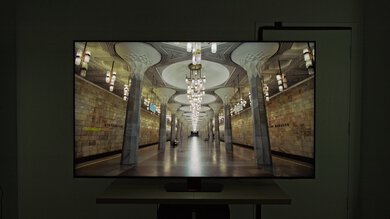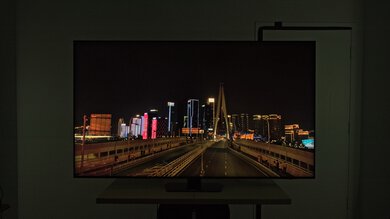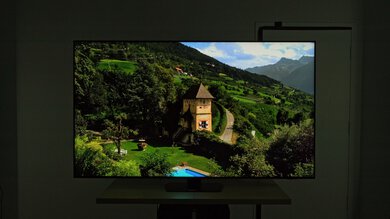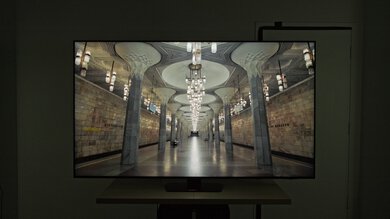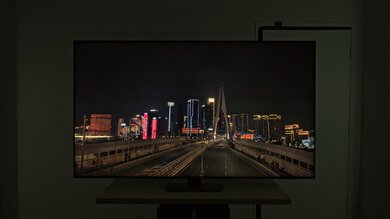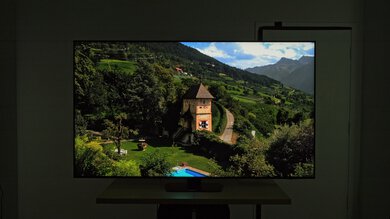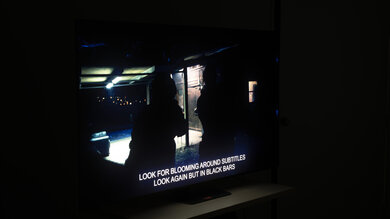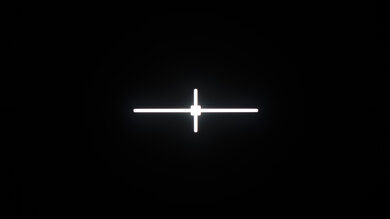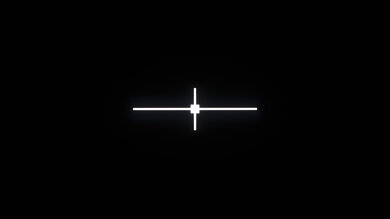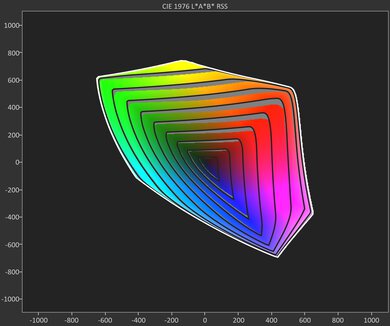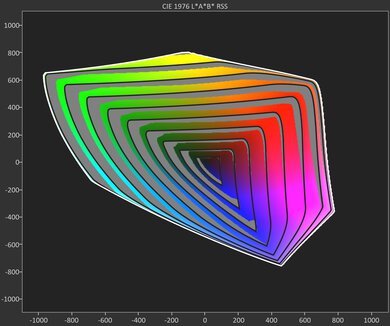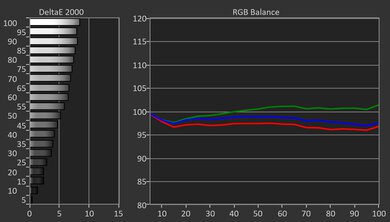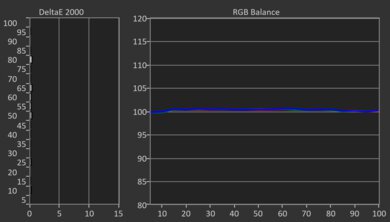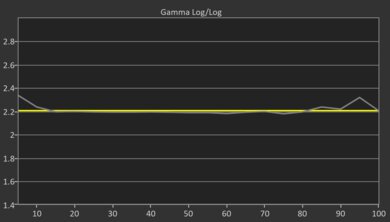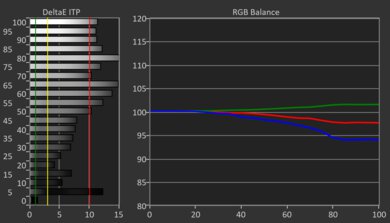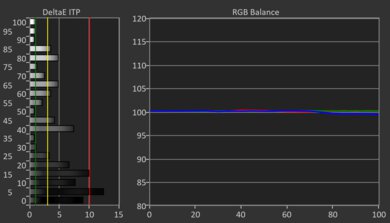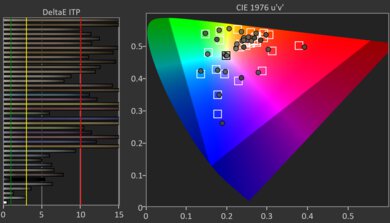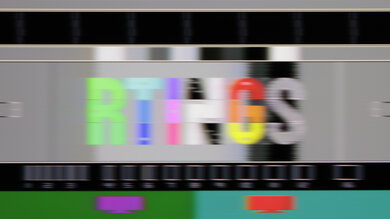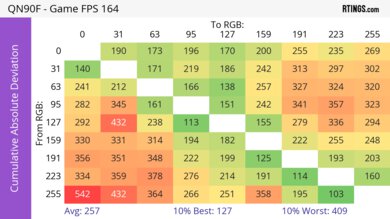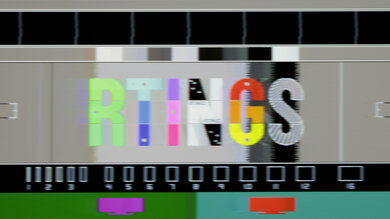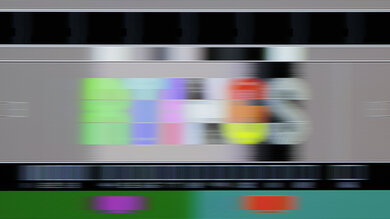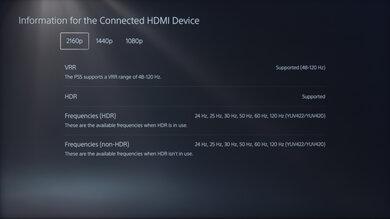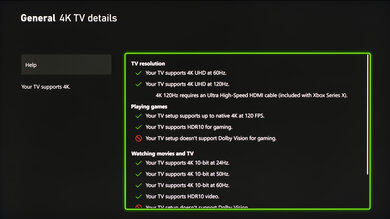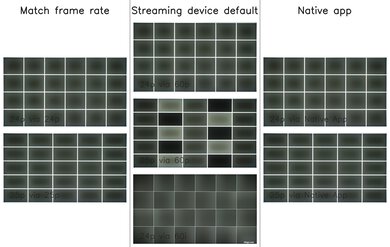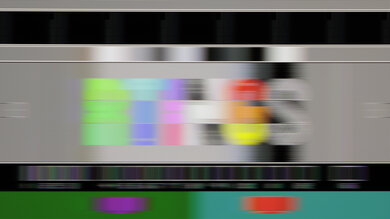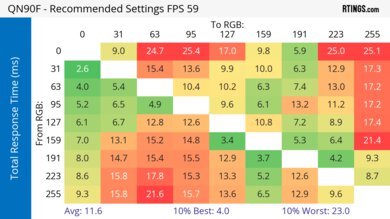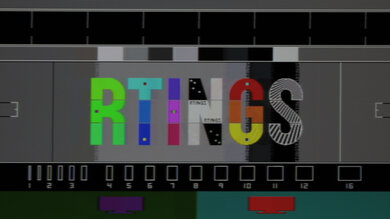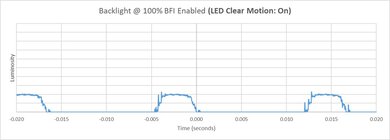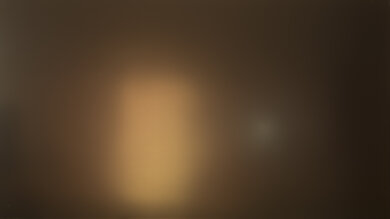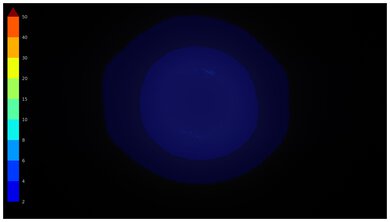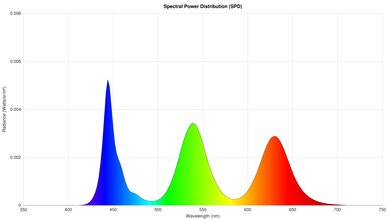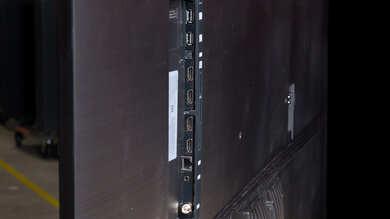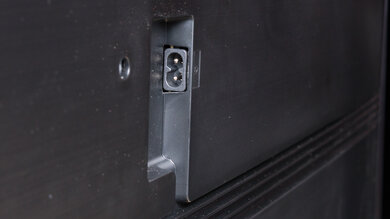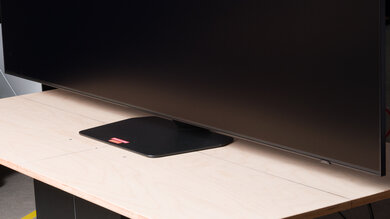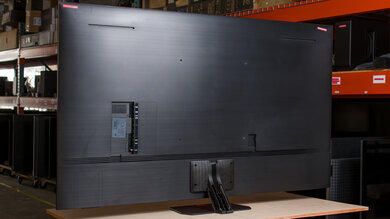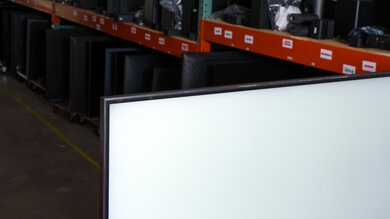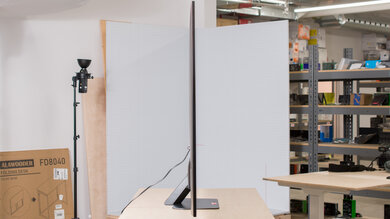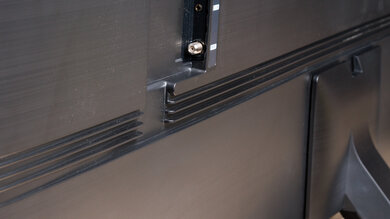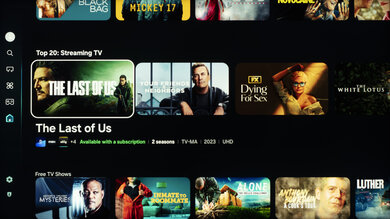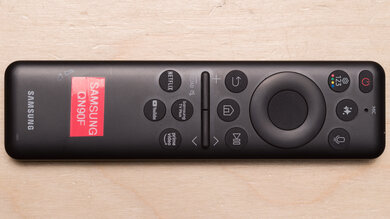The Samsung QN90F is an upper mid-range 4k TV released in 2025. It replaces the Samsung QN90D and sits above the Samsung QN85F and Samsung QN80F. Unlike its predecessor, the QN90F has a matte coating. It uses Samsung's Neo Quantum 4k AI Gen 3 processor, designed to improve performance and deliver better overall picture quality than its predecessor, the 4k AI Gen 2. The TV has 60W 4.2.2CH speakers built-in, has four full HDMI 2.1 ports with up to 4k @ 165Hz support, and uses the 2025 version of Samsung's Tizen OS. It has smart features like voice control and a web browser, and it's cast-capable. Like all Samsung TVs, it doesn't support the popular Dolby Vision HDR format, but it does support the similar HDR10+. We bought and reviewed the 75-inch model, but it's available in six other sizes: 43, 50, 55, 65, 85, and 98 inches.
Our Verdict
The Samsung QN90F is a great TV overall, as it excels in most contexts. It's extremely bright in SDR, and it handles reflections amazingly well, making it suitable for very bright rooms when watching sports or shows. Sadly, the TV's colors look a bit more washed out in bright rooms, and it's already not very colorful in SDR. Thankfully, it's extremely bright and colorful in HDR, with very good black levels, which also makes it a very good option in reference conditions, as highlights pop next to the TV's very deep blacks. Unfortunately, the TV's black levels suffer in Game Mode, with noticeably slower zone transitions, which offsets the TV's otherwise responsive Game Mode performance.
Very good black levels with little blooming.
Excellent HDR brightness for impactful highlights.
Incredibly bright in SDR.
HDMI 2.1 bandwidth on all four ports, all capable of up to 4k @ 165Hz with VRR support.
Colors are bright and vibrant in HDR.
Black levels are noticeably worse in Game Mode.
Slow pixel transitions in Game Mode leads to blurry motion.
The Samsung QN90F is very good for home theater aficionados. Its black levels are very good, with great contrast that keeps blacks deep even when bright highlights are present. Speaking of highlights, they're extremely bright on this TV due to its excellent HDR peak brightness; this TV really pops in darker rooms. It's also very colorful in HDR, with good color accuracy, although purists might want to get it calibrated. There is some response time stutter when watching 24 fps content, but it's not excessive. Unfortunately, the TV doesn't support Dolby Vision, and it also doesn't passthrough DTS audio formats or Dolby Digital Plus 7.1 through eARC.
Very good black levels with little blooming.
Excellent HDR brightness for impactful highlights.
Impressive low-resolution upscaling.
Colors are bright and vibrant in HDR.
Excellent PQ EOTF Tracking.
No Dolby Vision HDR, and no DTS and Dolby Digital Plus 7.1 passthrough.
Okay low-quality content smoothing, but it does leave some compression artifacts in the feed.
The Samsung QN90F is excellent for brighter rooms. It's extremely bright in SDR, and it handles direct reflections amazingly well, making the TV suitable for any room condition, no matter how bright. The TV is also quite colorful in HDR, although not so much in SDR; still, it's colorful enough for most users. Unfortunately, the TV looks a bit more washed out in brighter rooms, as its low-luminance colors lose some of their saturation in well-lit contexts. Thankfully, its black levels stay mostly very good, as they don't excessively raise in brighter environments.
Incredibly bright in SDR.
Handles direct reflections amazingly well.
Black levels are not too raised in brighter contexts.
Loses some of its color vibrancy in brighter rooms.
The Samsung QN90F is an excellent choice for sports enthusiasts. It's extremely bright in SDR and handles direct reflections, like from lamps or windows placed directly opposite the TV, amazingly well. Its upscaling is also great, so 720p and 1080p sports from cables or streaming apps look impressive on the TV's 4k screen. Unfortunately, its low-quality content smoothing isn't as good; good enough to clean up low-bitrate sports to some degree, but there's still some macro-blocking left in the feed. Its SDR color accuracy is just mediocre, so your favorite jerseys might not look exactly as you expect. At least the TV's viewing angle is decent, especially for an LED TV, making it a satisfactory choice for a wide seating arrangement.
Incredibly bright in SDR.
Handles direct reflections amazingly well.
Impressive low-resolution upscaling.
Relatively wide viewing angle, especially for an LED TV.
Only mediocre pre-calibration SDR accuracy.
Loses some of its color vibrancy in brighter rooms.
Okay low-quality content smoothing, but it does leave some compression artifacts in the feed.
The Samsung QN90F is a very good TV for gaming. It's very responsive due to its low input lag, full VRR support, and up to 4k @ 165Hz gaming. Its pixel transitions are only mediocre, good enough for those already used to gaming on an LED TV, but not fast enough for those used to OLEDs or faster gaming monitors. Thankfully, the TV looks great when gaming due to its high peak brightness in HDR and very colorful panel. Unfortunately, the TV's black levels take a hit when in Game Mode, with noticeably slower zone transitions and backlight control.
Excellent HDR brightness for impactful highlights.
HDMI 2.1 bandwidth on all four ports, all capable of up to 4k @ 165Hz with VRR support.
Colors are bright and vibrant in HDR.
Very low input lag at an resolution or refresh rate.
Black levels are noticeably worse in Game Mode.
Slow pixel transitions in Game Mode leads to blurry motion.
The Samsung QN90F is very bright in any content. In HDR, its brightness is excellent, leading to very bright highlights that pop out of the screen. The TV is also incredibly bright in SDR, enough for any room condition, even very bright ones.
Excellent HDR brightness for impactful highlights.
Incredibly bright in SDR.
The Samsung QN90F has great black levels. Its contrast is great, and it stays deep even when bright highlights are present, with minimal blooming due to its good lighting zone precision. Unfortunately, the TV's black levels take a hit when in Game Mode, with more blooming and noticeably worse zone transitions.
Very good black levels with little blooming.
Black levels are not too raised in brighter contexts.
Black levels are noticeably worse in Game Mode.
The Samsung QN90F has good color performance overall, especially due to its excellent HDR color volume; this TV truly pops in HDR, with good accuracy to boot, although purists will likely want to get this TV professionally calibrated. Unfortunately, it's not nearly as vibrant in SDR, and it's also less accurate there than in HDR; stick to HDR content for the best viewing experience.
Colors are bright and vibrant in HDR.
Only mediocre pre-calibration SDR accuracy.
Lacks some vibrancy in SDR.
Note:We're in the process of improving our tests related to image processing, but this score should give you a general idea of how a TV performs overall with its image processing capabilities.
The Samsung QN90F's image processing is good overall, with impressive low-resolution upscaling. Its HDR brightness accuracy is excellent, and while there's some banding in HDR gradients, it's not very noticeable. Its low-quality content smoothing is okay; it does clean up some compression artifacts, but there's a fair amount remaining in the feed.
Impressive low-resolution upscaling.
Excellent PQ EOTF Tracking.
Okay low-quality content smoothing, but it does leave some compression artifacts in the feed.
The Samsung QN90F is very responsive in Game Mode. It has very low input lag, supports every VRR technology, and can play games at up to 4k @ 165Hz. Unfortunately, its pixel transitions are just mediocre; good enough for anyone used to gaming on LED TVs, but a bit slow for anyone used to gaming on OLED panels or faster LED gaming monitors.
HDMI 2.1 bandwidth on all four ports, all capable of up to 4k @ 165Hz with VRR support.
Very low input lag at an resolution or refresh rate.
Slow pixel transitions in Game Mode leads to blurry motion.
We're in the process of fixing the way we evaluate a TV's overall motion handling. This section is currently broken, and the score isn't indicative of how well a TV handles motion overall.
Performance Usages
Changelog
-
Updated Oct 22, 2025:
We retested the TV with firmware 1125. We updated the review with improved results in the Black Uniformity, PQ EOTF Tracking, HDR Brightness, HDR Pre-Calibration, and HDR Post-Calibration sections. We also refreshed some text throughout the review to reflect the improvements.
-
Updated Oct 21, 2025:
We bought and tested the TCL QM9K and added a comparison in the HDR Brightness section.
-
Updated Oct 21, 2025:
This review has been updated to Test Bench 2.1. We wrote text for the newly added Micro-Judder test, refreshed the text in the updated Judder section, and tweaked the text in the renamed Response Time Stutter section.
- Updated Oct 21, 2025: We added text to the new Micro-Judder section and refreshed the text in the updated Judder and Response Time Stutter sections after converting the review to TV 2.1.
Check Price
Differences Between Sizes And Variants
We bought and tested the 75-inch Samsung QN90F, and these results are also valid for the 55-inch, 65-inch, 85-inch and 98-inch models. The two smaller models have fewer speakers (20W 2 channels on the 43-inch, 40W 2.2 channels on the 50-inch), and have Neo Quantum HDR instead of Neo Quantum HDR+, which means that they're likely not as bright or as colorful as the bigger models. It's also sold as the Samsung QN90FD at some warehouse retailers, including Costco. The FD variant has a longer warranty but otherwise performs the same. Note that the last five letters in the model number (DFXZA in this case) vary between retailers and individual regions, but there's no difference in performance.
| Size | US Model | Short Model Code | Costco Variant | Neo Quantum HDR+ | Speakers |
|---|---|---|---|---|---|
| 43" | QN43QN90FAFXZA | QN43QN90F | - | No | 20W, 2.0 |
| 50" | QN50QN90FAFXZA | QN50QN90F | - | No | 40W, 2.2 |
| 55" | QN55QN90FAFXZA | QN55QN90F | - | Yes | 60W, 4.2.2 |
| 65" | QN65QN90FAFXZA | QN65QN90F | QN65QN90FDFXZA | Yes | 60W, 4.2.2 |
| 75" | QN75QN90FAFXZA | QN75QN90F | QN75QN90FDFXZA | Yes | 60W, 4.2.2 |
| 85" | QN85QN90FAFXZA | QN85QN90F | QN85QN90FDFXZA | Yes | 60W, 4.2.2 |
| 98" | QN98QN90FAFXZA | QN98QN90F | - | Yes | 60W, 4.2.2 |
Our unit was manufactured in February 2025.
Popular TV Comparisons
The Samsung QN90F is a very good TV, and it excels in most use cases, but it's not quite as good as other high-end models from competing brands like the TCL QM9K. It's extremely bright in HDR and SDR, and its matte coating does an amazing job of dealing with any direct light sources. Unfortunately, while it supports 4k @ 165Hz on all four of its HDMI ports, its zone transitions are noticeably worse in Game Mode, making it a tough option for gamers. Ultimately, last year's 2024 Samsung QN90D/QN90DD QLED is a bit better overall, with better contrast, although it loses some of its brightness in Game Mode instead of having slower zone transitions. Still, the QN90F is an enticing choice for people wanting an LED TV with a matte coating, as it's a noticeable step up in performance when compared to TVs like Samsung The Frame 2024, the TCL NXTVISION, or the Hisense CanvasTV 2024.
For more options, check out our recommendations for the best QLED TVs, the best 4k gaming TVs, and the best TVs.
The Samsung QN90D and Samsung QN90F are extremely similar TVs, but, overall, the older QN90D has a very slight edge over its successor, mostly due to its noticeably better contrast and color vibrancy. For gamers, it's a wash: the QN90D loses a lot of its HDR brightness in Game Mode, and the QN90F doesn't, but inversely, the newer model has noticeably worse zone transitions in Game Mode, giving it worse black levels than its predecessor when gaming. PC gamers will, however, appreciate the QN90F's 165Hz support and slightly faster pixel transitions, although it's a minor improvement. The biggest advantage of the QN90F is its far better direct reflection handling due to its matte coating.
The Samsung S90F and the Samsung QN90F use different panel technologies that target different users, so the best one ultimately depends on how you plan to use it. With its QD-OLED panel, the S90F delivers perfect blacks in a dark room with no distracting haloing or raised blacks. It also delivers a better gaming experience thanks to its nearly instantaneous response time. The QN90F, on the other hand, is a lot brighter, so it can handle more glare when used in a bright room. It's no slouch for dark room viewing, either, but its blacks just aren't as deep as they are on the S90F.
The Samsung QN90F is significantly better than the Samsung QN80F in almost every way. The QN90F delivers much better picture quality, with better contrast, higher peak brightness, and better colors. They're more closely matched when it comes to gaming and motion, though, as both have noticeable blur in fast scenes and a similar selection of gaming features. Still, even gamers will benefit from the better picture quality the QN90F delivers, so it's still the far better TV.
The Samsung S95F is a much better TV than the Samsung QN90F. The S95F's OLED panel delivers a much better dark room experience, with deep, inky blacks and nearly infinite contrast that gives the image more depth. Colors are also significantly brighter and more vibrant on the S95F. The QN90F is a lot brighter in SDR, though, so even though the S95F is no slouch either, the QN90F is the slightly better choice if you mainly watch TV during the day.

We buy and test dozens of TVs yearly, taking an objective, data-driven approach to deliver results you can trust. Our testing process is complex, with hundreds of individual tests that take over a week to complete. Most of our tests are done with specially designed test patterns that mimic real content, but we also use the same sources you have at home to ensure our results match the real-world experience. We use two main tools for our testing: a Colorimetry Research CR-100 colorimeter and a CR-250 spectroradiometer.
Test Results
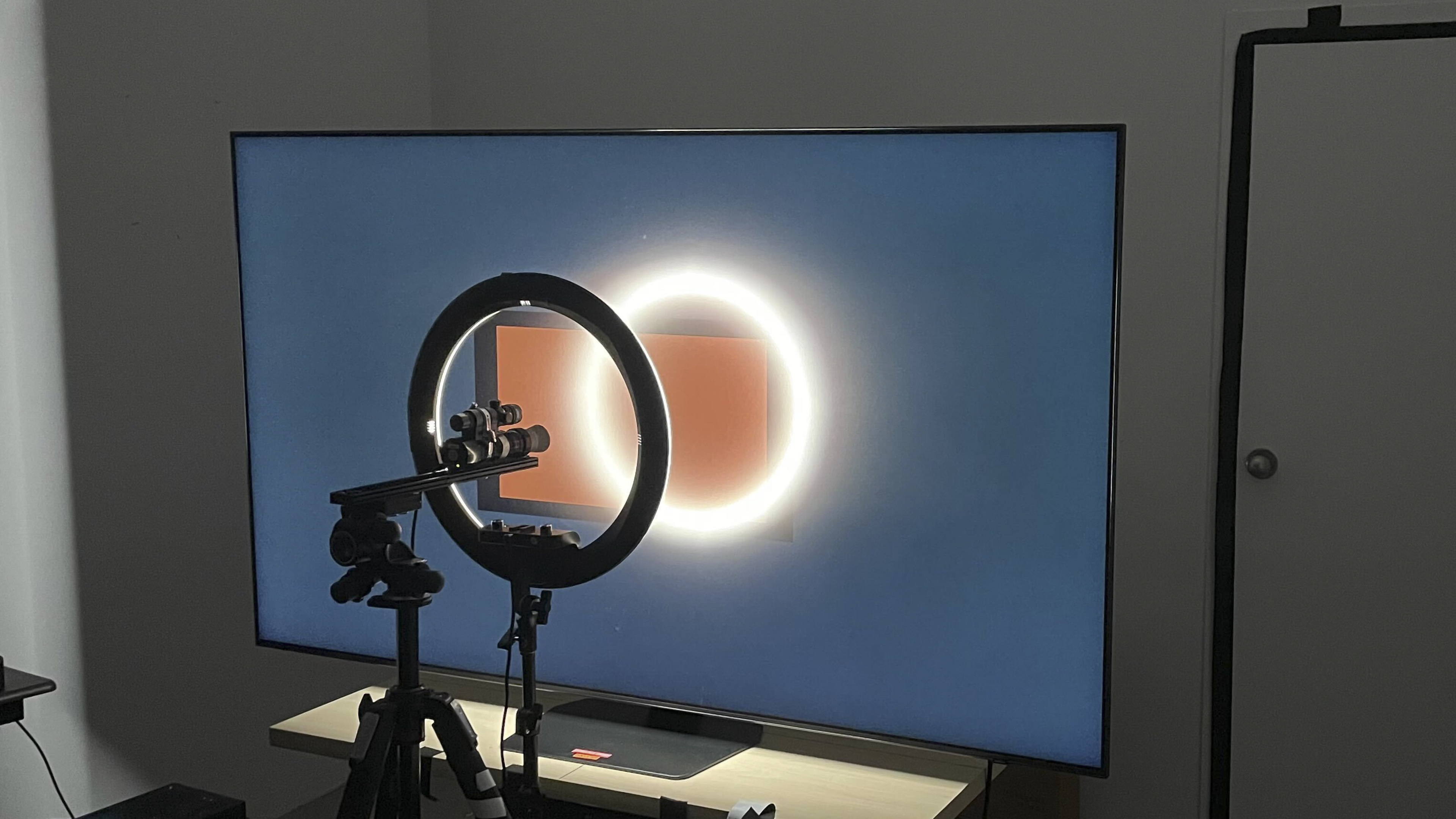
The Samsung QN90F has amazing HDR brightness. Highlights really pop out during darker scenes, and although it's not as bright as the TCL QM9K, it's bright enough that very bright specular highlights stand out in well-lit scenes. While brighter scenes aren't nearly as bright as smaller highlights, they're still impressively bright, even when the entire screen is bright.
Our results are done in the 'Movie' Picture Mode with 'HDR Tone Mapping' set to 'Static'. If you prefer a brighter image, these are the results with 'HDR Tone Mapping' set to 'Active':
- Hallway Lights: 1008 cd/m²
- Yellow Skyscraper: 921 cd/m²
- Landscape Pool: 485 cd/m²
The TV is a bit dimmer when using Game Mode, but it's barely noticeable. The above results are with Game HDR set to 'Basic' and HDR Tone Mapping set to 'Static.'
Unfortunately, Samsung removed HGIG with firmware update 1125.9. Their intention was to move it to the "Original" Game Genre setting, but it's still not working properly as of firmware 1125.
Results with 'HDR Tone Mapping' set to 'Active':
- Hallway Lights: 1041 cd/m²
- Yellow Skyscraper: 535 cd/m²
- Landscape Pool: 301 cd/m²
The Samsung QN90F has fantastic SDR brightness. Even though small bright areas are a lot brighter than larger ones, the TV is consistently bright and easily overcomes glare in even the brightest of rooms no matter the content.
The Samsung QN90F's contrast is great with local dimming on 'High', as it provides very deep blacks in a dark room, and they stay deep when bright highlights are also on screen. You cannot disable local dimming on this TV, so its native contrast was measured with an inverted contrast pattern. Overall, even though this TV's contrast is very impressive, it's a downgrade from the Samsung QN90D/QN90DD QLED.
The TV's lighting zone precision is good, but there's some noticeable blooming around bright objects and subtitles when displayed against a black background. The step-up Samsung QN990F 8K has slightly better zone dimming, but it's not a huge difference.
The TV has decent lighting zone transitions. Unfortunately, the leading edge of bright highlights when they quickly move across the screen is visibly dimmer, and there's very noticeable haloing.
The TV has very good black uniformity with local dimming enabled. Blacks are deep and uniform across the screen, with only some minor blooming around bright objects on a dark background. Local dimming can't be turned off on this TV, so we tested its native black uniformity with Local Dimming set to 'Low' and Shadow Detail to '1', with a uniformity image set to pure black.
The TV's SDR color volume is alright. It has good coverage of the commonly used DCI-P3 color space, although it can't quite fully display bright greens, yellows, and oranges. The TV has mediocre coverage of the wider BT.2020 color space; its color volume isn't quite good enough to fully display most colors, although it fares much better with very light colors than it does others.
Despite the similarities in the overall panel, this TV delivers much better colors than the entry-level Samsung QN80F. Unlike the QN80F, colors don't desaturate at high luminance levels.
| Volume ΔE³ | DCI-P3 Coverage |
BT.2020 Coverage |
|---|---|---|
| L10 | 89.43% | 68.43% |
| L20 | 88.88% | 66.78% |
| L30 | 87.96% | 66.05% |
| L40 | 86.72% | 66.91% |
| L50 | 85.89% | 66.73% |
| L60 | 83.12% | 62.81% |
| L70 | 81.61% | 54.74% |
| L80 | 82.83% | 53.43% |
| L90 | 85.15% | 56.86% |
| L100 | 89.82% | 83.01% |
| Total | 84.67% | 61.31% |
Results above are with Color Space set to 'Native,' with Color Booster Pro set to 'Off.' The TV is, however, more colorful, although less accurate, with Color Booster Pro set to 'High' in both the DCI-P3 (87.70%) and BT.2020 (66.36%) color spaces.
The TV has amazing HDR color volume. It displays a wide range of colors at high luminance levels, and dark, saturated colors are displayed well due to its great contrast. Its colors are significantly more vibrant than lower tier models from this brand, such as the Samsung Q7F 2025.
The Samsung QN90F has mediocre SDR pre-calibration accuracy. The white balance is off, as greens are overrepresented in brighter grays, while blues and reds are underrepresented in all grays. This makes the TV's color temperature slightly too cold. Its color accuracy is decent; colors deviate from what they should be, and desaturated colors have mild accuracy issues across the board. Gamma is unfortunately too dark in dim and bright scenes.
After calibration, the TV has fantastic SDR accuracy. However, due to local dimming always being on, it can be a bit tricky to calibrate since the TV's dimming zones adjust to the presence of the calibration window. Overall, it's a noticeable improvement on all fronts, with nearly perfect white balance and color temperature. While color accuracy is also vastly improved, it's not perfect, as most colors are still slightly off the mark.
You can see our full calibration settings.
The TV has good pre-calibration accuracy in HDR. Its white balance is good, although blues and reds are underrepresented in brighter grays, while greens are overrepresented in the same range. Fortunately, the color temperature is just a tad warmer than the industry standard 6,500K. Color accuracy is decent, but there are noticeable mapping issues in most colors.
The TV's accuracy is great after calibration. The white balance is vastly improved, but it's still not perfect overall, and there are inaccuracies in darker grays. The TV's color temperature is a bit colder than it was pre-calibration, but it's still very close to 6,500K. Color accuracy has improved a bit, but it's far from perfect, as there are still some noticeable color mapping issues in many colors.
The Samsung QN90F has excellent PQ EOTF tracking. Near-blacks are a bit too dim, and some midtones and highlights are slightly too bright, but the TV mostly follows the curve closely. There's a gradual roll-off near the TV's peak brightness to retain detail in highlights in all mastered content, although the TV is bright enough to fully display most content mastered at 600 nits and 1000 nits.
Update 10/22/2025: Samsung removed HGIG with firmware update 1125.9. Their intention was to move it to the "Original" Game Genre setting, but it's still not working properly as of firmware 1125. This means that most games won't be displayed at the correct brightness level, and it's especially problematic for Switch 2 players, as HGIG is needed to properly calibrate that console's HDR output.
The TV has alright low-quality content smoothing. It does a good job with preserving detail, but it only does an okay job at actually smoothing out artifacts, so there's still visible macro blocking present in low-bitrate content.
The TV has an optional feature to help reduce artifacts from interlaced sources. To use it, 'Film Mode' must be set to 'Auto.'
The TV has decent HDR native gradient handling. Most colors have minimal banding, but bright grays, greens, and blues have more noticeable banding.
This TV has extremely low input lag at all refresh rates when set to Game Mode, which ensures a very responsive gaming experience with very little delay between your actions with your controller or mouse and the action on-screen. Outside of Game Mode, its input lag is a lot higher, so you feel a slight delay when scrolling through menus or pausing content.
To use motion interpolation in Game Mode, the input label must be set to 'Game Console.'
The Samsung QN90F supports most common resolutions up to 4k @ 165Hz, although it doesn't support 144Hz. Chroma 4:4:4 signals are displayed properly with all supported resolutions when the TV's input label is set to 'PC,' which is important for text clarity.
The Samsung QN90F supports all three types of variable refresh rate (VRR) technology to reduce screen tearing. It works well across a wide refresh rate range and supports sources with Low-Frame-Compensation (LFC), which ensures your games remain nearly tear-free even when your frame rate drops very low.
The TV's CAD at its maximum refresh rate of 165Hz is acceptable. This model does struggle a bit when going from very bright shades to very dark ones, but it performs better when going from darker shades to brighter ones. Furthermore, there's barely any overshoot, so you don't see any inverse ghosting.
The Samsung QN90F's CAD transitions are a bit faster at 120Hz than at 165Hz, but not by much. Here there's some overshoot when going from a dark state to a brighter one, leading to some inverse ghosting.
The TV's CAD at 60Hz is similar to its performance at 120Hz and 165Hz. Like at 165Hz it's slower when going from brighter states to darker ones. There's also some notable persistence blur due to its slower refresh rate. There's some minor overshoot when going from dark states to brighter ones, but not enough to cause any truly noticeable inverse ghosting.
The TV is fully compatible with everything the PS5 offers, like 1440p @ 120Hz and 4k @ 120Hz, as well as HDMI Forum VRR. It also supports Auto Low Latency Mode, so you don't have to worry about manually switching to Game Mode to get the lowest input lag.
The TV is fully compatible with almost everything the Xbox Series X|S offers, including 1440p @ 120Hz, 4k @ 120Hz, HDMI Forum VRR, and FreeSync Premium Pro. It also supports Auto Low Latency Mode, so you don't have to manually switch to Game Mode to get the lowest input lag. Unfortunately, Dolby Vision isn't supported on the TV, so gaming in Dolby Vision isn't possible.
This TV has visible response time stutter when watching low frame rate content like movies and TV shows, especially in slow panning shots. It's not quite as bad as TVs with OLED panels, like the Samsung S95F OLED, but it's still noticeable in some scenes.
The Samsung QN90F is free from 24p micro-judder regardless of the source. There's also no micro-judder when watching 25p content from the TV's native apps or from external devices sending a 25Hz signal.
As originally shown by HDTVTest, this Samsung TV has a very minor instance of micro-judder right after starting a video or when exiting a full screen of black, but this lasts less than a second and goes away completely after that, so it's not a big deal at all. However, there's consistent micro-judder (and regular judder) when watching 25p content via a 60p signal, like when using older streaming devices.
The TV automatically removes judder from all sources when watching movies or shows that are in 24p, even if they're in a 60Hz signal, like from a cable box or an older streaming device. It also removes judder from 25p sources if you're using the TV's native apps or an external device that sends a 25Hz signal. However, it doesn't remove judder from 25p sources that are being sent via a 60p signal. Furthermore, frame times are incredibly inconsistent, which makes motion look jerky and distracting when watching 25p content via 60p.
The TV uses pulse-width modulation (PWM) to dim its backlight, which introduces flicker that can bother people who are sensitive to it. The TV flickers at 120Hz in most picture modes and brightness levels, except in the 'Movie' Picture Mode, where it flickers at 960Hz when the brightness is below 20.
It has an optional backlight strobing feature, commonly known as black frame insertion (BFI). This feature reduces blur caused by the TV's fast response time, otherwise known as persistence blur. It only works at 60Hz, and even though there is some minor image duplication, it's hard to notice.
This TV has an optional motion interpolation feature to improve the clarity of motion. It does a decent job of smoothing out slower scenes, but there are some noticeable artifacts present during slow panning shots. In faster-moving scenes, it doesn't keep up, and there are distracting artifacts, and small details in fine elements, like hair, get lost.
The Samsung QN90F has excellent direct reflections handling. Its matte coating does an outstanding job at significantly reducing direct reflections, such as from sources of light placed directly opposite the screen. Furthermore, the intensity of the brightness of reflections is greatly reduced, so it performs amazingly well in a bright room. This makes it a better choice for a really bright room than TVs with a glossy coating, like the TCL QM8K.
The TV's black levels raise a little in brighter contexts, but blacks stay deep and don't look overly washed out.
The Samsung QN90F does a great job with total reflected light. Its matte coating significantly reduces the intensity of indirect reflections, and it does so without any visual artifacts like rainbow smearing or light banding, although it does end up spreading out the reflections more than a glossy coating would.
The TV has sub-par color saturation in a bright room, as the saturation of low-luminance colors noticeably drops in a room with ambient lighting. It fares much better with mid-luminance and high-luminance colors, but they also lose some saturation in brighter rooms, but it's harder to notice.
The Samsung QN90F has a decent viewing angle. The image is consistent when viewed from a slight angle, but there's color shifting, color washout, and brightness loss the more you move off-center. Still, its black levels don't raise at all from an angle, and overall it's a satisfactory choice for a wide seating arrangement.
The TV uses a BGR (Blue-Green-Red) subpixel layout instead of the traditional RGB layout. For video or gaming content, this doesn't cause any issues, but for PC monitor use, it can be a problem as it impacts the text clarity, although not everyone notices this.
The TV has great separation between colors, which helps with its color purity and its ability to display a wide range of colors.
The Samsung QN90F supports the full 48Gbps bandwidth of HDMI 2.1 on all four HDMI ports. This allows you to take full advantage of multiple high-bandwidth devices. Unfortunately, it only has an ATSC 1.0 tuner, so 4k over-the-air isn't possible.
The Samsung QN90F supports Dolby Digital audio formats. However, it doesn't passthrough Dolby Digital Plus 7.1. Unfortunately, it also doesn't support DTS formats, which is disappointing, as many Blu-rays use DTS for their lossless audio tracks.
7.1 channel LPCM only works with sources that allow you to manually override the EDID, like a PC. If you can't override the EDID, it's limited to 5.1.
Like all Samsung TVs, the Samsung QN90F doesn't support Dolby Vision, but it does support the similar HDR10+.
The Samsung QN90F looks similar to previous models, like the Samsung QN90D and Samsung QN90C, with thin bezels and a centrally mounted stand. It looks like a premium model.
The back of the TV has a nice textured design. There are grooves that can be used to guide wires into the TV's stand to help with cable management. Unfortunately, the inputs are housed in a recessed cutout, making them hard to access when the TV is mounted flush to the wall.
The TV has an okay frequency response. Like most models, the bass is almost non-existent, and it sounds noticeably more unbalanced at max volume than at moderate levels. The speakers are good enough for clear dialogue at moderate listening levels, however.

